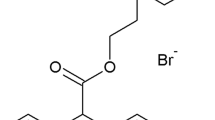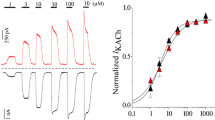Summary
The action of the cervane alkaloid, imperialine, has been assessed at M1, M2 and M3 receptors in functional assays and at M1, M2, M3 and putative M4 sites in binding studies. In functional studies, imperialine acted as a selective surmountable antagonist at M2 receptors in guinea-pig isolated atria and uterus (−log KB = 7.7 and 7.4, respectively), in comparison to M1, receptors in canine isolated saphenous vein (−log KB = 6.9) or M3 receptors in a range of guinea-pig isolated smooth muscles including ileum, trachea, fundus, seminal vesicle or oesophagus (−log KB = 6.6–6.8). In rat aorta, the −log KB value at the M3 receptor (5.9) was slightly, but significantly, lower.
In competition radioligand binding studies, imperialine was also selective toward to M2 sites in rat myocardium (−log Ki = 7.2) with respect to M1 and M3 sites (rat cerebral cortex, rat submaxillary gland; −log Ki = 6.1 and 5.7, respectively). However, it did not significantly discriminate between rat cardiac M2 sites and putative M4 sites in rabbit lung (−log Ki = 6.9).
Imperialine resembles the alkaloid himbacine in terms of its pharmacological profile at muscarinic receptor subtypes in that it acts as an M2 selective antagonist with respect to M1 or M3 sites. It may also provide a second, commercially available, antagonist with which to discriminate between M1 and M4 receptors.
Similar content being viewed by others
References
Arunlakshana O, Schild HO (1959) Some quantitative uses of drug antagonists. Br J Pharmacol 14:48–58
Blinks JR (1966) Convenient apparatus for recording contractions of isolated heart muscle. J Appl Physiol 20:755–757
Caulfield MP, Brown DA (1991) Pharmacology of the putative M4 muscarinic receptor mediating Ca-current inhibition in neuroblastoma glioma (NG108–15) cells. Br J Pharmacol 104:39–44
Cheng YC, Prusoff WH (1973) Relationship between the inhibition constant (Ki) and the concentration of inhibitor which causes 50% inhibition (IC50) of an enzymatic reaction. Biochem Pharmacol 22:3099–3108
Cheung YD, Barnett DB, Nahorski SR (1982) [3H]-rawolscine and [3H]-yohimbine binding to rat cerebral and human platelet membranes: possible heterogeneity of alpha2-adrenoceptors. Eur J Pharmacol 84:79–85
Clague RU, Eglen RM, Strachan AS, Whiting RL (1985) Action of agonists and antagonists present on ileum and atria. Br J Pharmacol 87:163–170
Coleman RA (1987) Methods in prostanoid receptor classification. In: Benedetto E, McDonald-Gibson RG, Nigam S, Slater TF (eds) Prostaglandins and related substances. IRL Press, Oxford, pp 267–303
Darroch SA, Taylor WC, Choo LK, Mitchelson F (1990) Structure-activity relationships of some galbulimina alkaloids related to himbacine. Eur J Pharmacol 182:131–136
Delmendo R, Michel AD, Whiting RL (1989) Affinity of muscarinic receptor antagonists for three putative muscarinic receptor binding sites. Br J Pharmacol 96:457–464
Del Tacca M, Danesi R, Blandizzi C, Bernadini MC (1990) Differential affinities of AF-DX 116, atropine and pirenzepine for muscarinic receptors of guinea-pig fundus, atria and urinary bladder: might atropine distinguish among muscarinic receptor subtypes. Pharmacologist 40:241–249
Doods HN, Mayer N (1989) UH AH 37, an ileal selective muscarinic antagonist that does not discriminate between M2 and M3 binding sites. Eur J Pharmacol 161:215–218
Dorje F, Wess J, Lambrecht G, Tacke R, Mutschler E, Brann MR (1991a) Antagonist binding profiles of five cloned human muscarinic receptor subtypes. J Pharm Exp Ther 258:727–733
Dorje F, Levey AI, Brann MR (1991b) Immunological detection of muscarinic receptor subtype proteins (ml–m5) in rabbit peripheral tissues. Mol Pharmacol 40:459–462
Eberlein WG, Engel W, Mihm G, Rudolf K, Wetzel B, Entzeroth M, Mayer N, Deeds HN (1989) Structure activity relationships and pharmacological profile of selective tricyclic antimuscarinics. Trends Pharmacol Sci 10 [Suppl]:50–54
Eglen RM, Whiting RL (1990) Heterogeneity of vascular muscarinic receptors. J Anton Pharmacol 19:187–200
Eglen RM, Montgomery WW, Dainty IA, Dubuque LK, Whiting RL (1988) The interaction of methoctramine and himbacine at atrial, smooth muscle and endothelial muscarinic receptors, in vitro. Br J Pharmacol 95:1031–1038
Eglen RM, Michel AD, Whiting RL (1989) Characterization of the muscarinic receptor subtype mediating contractions of the guinea-pig uterus. Br J Pharmacol 96:497–499
Eglen RM, Michel AD, Montgomery WW, Kunysz EA, Machado CA, Whiting RL (1990) The interaction of parafluorohexahydrosiladifenidol (pFHHSiD) at muscarinic receptors in vitro. Br J Pharmacol 99:637–642
Eglen RM, Michel AD, Levine WB, Whiting RL (1991) Analysis of muscarinic receptors in guinea-pig oestrogen dominated uterus, in vitro. Br J Pharmacol 104:44P
Eglen RM, Harris GC, Cox H, Stefanich E, Sullivan A, Whiting RL (1992) Characterization of the interaction of imperialine at muscarinic receptors in vitro. Br J Pharmacol 105:105P
Emmerson J, McKay D (1979) The zig-zag tracheal strip. J Pharm Pharmacol 5:323–346
Furchgott RF (1972) The classification of adrenoceptors (adrenergic receptors): An evaluation from the standpoint of receptor theory. In: Blaschko H, Muscholl E (eds) Catecholamines (Handbook of experimental pharmacology, vol 33). Springer, Berlin Heidelberg New York, pp 283–335
Gilani SA, Cobbin LB (1986) The cardio-selectivity of himbacine: a muscarinic receptor antagonist. Naunyn-Schmiedeberg's Arch Pharmacol 332:16–20
Gilani SA, Cobbin LB (1987) Interaction of himbacine with carbachol at muscarinic receptors of heart and smooth muscle. Arch Int Pharmacodyn 290:46–53
Hammer R, Berrie CP, Birdsall NJM, Burgen ASV, Hulme EC (1980) Pirenzepine distinguishes between different subclasses of muscarinic receptors. Nature 283:90–92
Honkanen RE, Howard EF, Abdel-Latif AA (1990) M3 muscarinic receptor subtype predominates in the bovine in sphincter muscle and ciliary processes. Invest Opthal Vis Sci 31:590–593
Hulme EC, Buckley NJ, Birdsall NJM (1990) Muscarinic receptor subtypes. Ann Rev Pharmacol Toxicol 30:633–673
Ito S, Fukazawa Y, Miyashita M (1976) Structure of imperialine. Tetrahedron Lett 36:3161–3164
Kamikawa Y, Uchida K, Shumo Y (1985) Heterogeneity of muscarinic receptors in the guinea-pig oesophageal muscularis mucosae and ileal longitudinal muscle. Gastroenterology 88:706–716
Kilbinger M, Schneider R, Siefken M, Wolf D, D'Agostino G (1991) Characterization of prejunctional muscarinic autoreceptors in the guinea-pig trachea. Br J Pharmacol 103:1757–1763
Kunysz EL, Michel AD, Whiting RL, Woods K (1989) The human astrocytoma cell line 1321 N1 contains M2-glandular type muscarinic receptors linked to phosphoinositide turnover. Br J Pharmacol 96:271–278
Lazareno S, Buckley NJ, Roberts FF (1990) Characterization of muscarinic M4 binding sites in rabbit lung, chicken heart and NG108–15 cells. Mol Pharmacol 38:805–815
Lee NH, El-Fakahany E (1990) The allosteric binding profile of himbacine: a comparison with other cardioselective muscarinic antagonists. Eur J Pharmacol 179:225–229
Lee NH, El-Fakahany E (1991) Allosteric antagonists of the muscarinic acetylcholine receptor. Biochem Pharmacol 42:199–205
Levine RR, Birdsall NJM (1989) Subtypes of muscarinic receptors IV. Trends Pharm Sci [Suppl] 10:1–119
Michel AD, Whiting RL (1984) Analysis of ligand binding data using a microcomputer. Br J Pharmacol 83:460P
Michel AD, Stefanich E, Whiting RL (1989) Direct labeling of rat M3-muscarinic receptors by [3H]4-DAMP. Eur J Pharmacol 166:459–466
Mir GN, Ghatak BJR (1965) Pharmacological investigation of imperialine — an alkaloid from Fritillaria imperialis Linne. Ind J Exp Biol 3:249–252
Mipzaev YR, Plomikova IT, Shakirov R, Samikov K, Koolkova VV (1991) Blocking activity of the M2 muscarinic receptors by C-nor, D-homosteroidal alkaloids from the plants of the Petileum and Korolkowia genera. Chem Pharm 4:50–53
Monferini E, Cereda E, Ladensky M, Donetti A, Giraldo E (1990) Guanylpirenzepine distinguishes between neuronal m1 and m4 muscarinic receptor subtypes. J Recept Res 10:81–96
Paton WDM, Rang HP (1965) The uptake of atropine and related drugs by intestinal smooth muscle of the guinea-pig in relation to acetylcholine receptors. Proc Roy Soc B 163:1–21
Sharif SI, Gokhale SD, Chandranath SI (1990) Pharmacological characterization of the postjunetional alpha-adrenoceptors of the rat isolated seminal vesicle. Naunyn-Schmiedeberg's Arch Pharmacol 341:425–431
Author information
Authors and Affiliations
Additional information
Send offprint requests to R. M. Eglen at the above address
Rights and permissions
About this article
Cite this article
Eglen, R.M., Harris, G.C., Cox, H. et al. Characterization of the interaction of the cervane alkaloid, imperialine, at muscarinic receptors in vitro. Naunyn-Schmiedeberg's Arch Pharmacol 346, 144–151 (1992). https://doi.org/10.1007/BF00165295
Received:
Accepted:
Issue Date:
DOI: https://doi.org/10.1007/BF00165295




